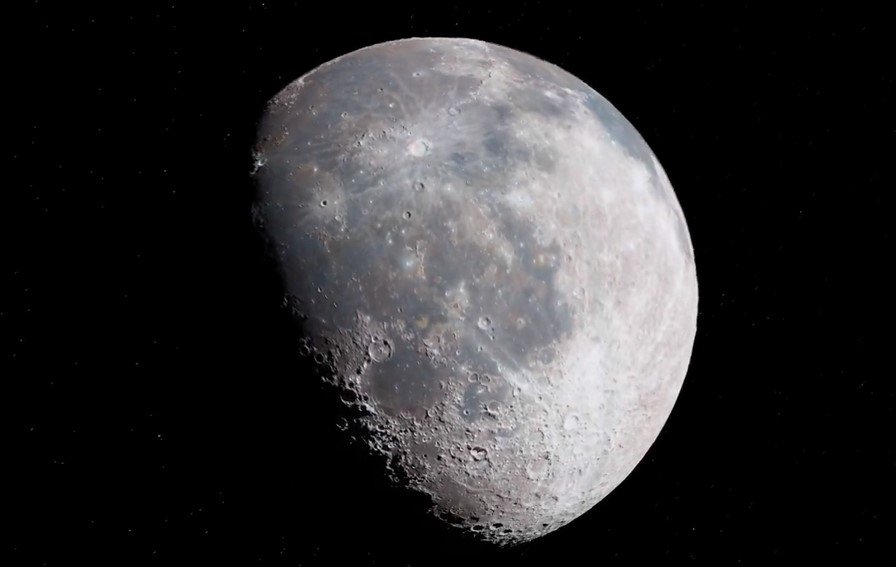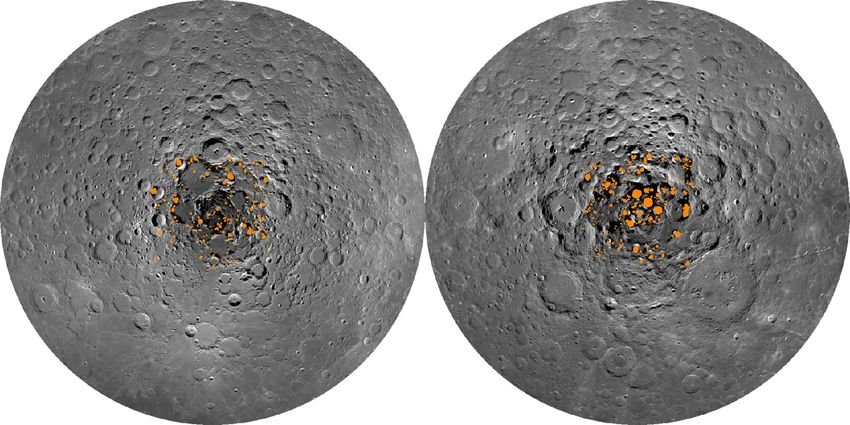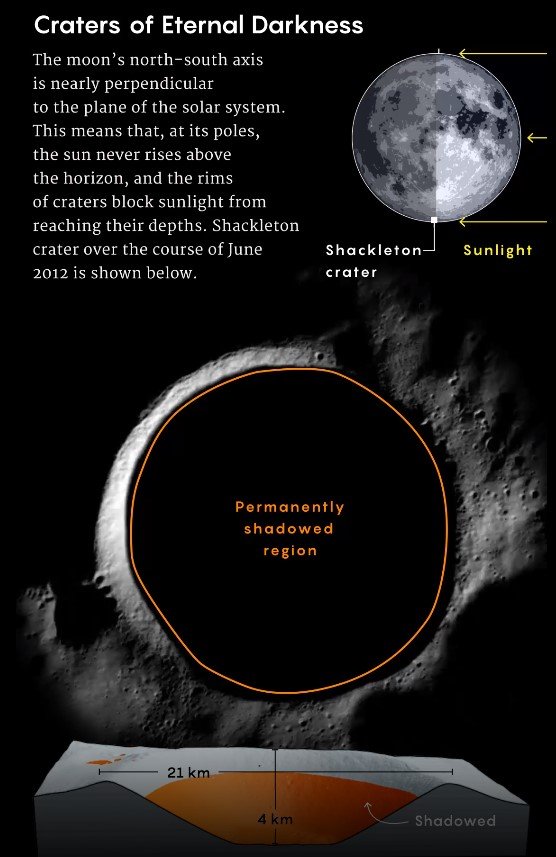NASA is sending robots to venture into the sunless depths of lunar craters to find ancient water in the form of ice. They will tell us about how water got to the rocky planets.

On October 9, 2009, a 2-ton Atlas rocket crashed into the moon while traveling at 9.000 kilometers the hour. As it exploded onto the lunar surface a shower of dust created by the impact heated the lunar surface to hundreds of degrees Celsius, and the black crater it fell into, called Cabeus, briefly lit up for the first time in billions of years.
The crash was no accident. NASA's Lunar Crater Observation and Sensing Satellite, abstract LCROSS (Lunar Crater Satellite Observation and Detection Mission) aimed to see what would be ejected from the impact.
A spacecraft following the rocket flew through the dust plume to measure the dust's materials, while the NASA's Lunar Reconnaissance Orbiter (a robotic NASA spacecraft orbiting the Moon) observed from afar.
The results of the experiment were surprising: The scientists detected 155 kg of water vapor mingled in the cloud of dust. They had, for the first time, found water on the moon. "It was absolutely final," said o Anthony Colaprete of NASA Ames Research Center, LCROSS principal investigator.
The moon is obviously not a reservoir of water. The lack of atmosphere and extreme temperatures should cause any water to evaporate almost immediately. However, about 25 years ago, spacecraft began to detect traces of hydrogen around the moon's poles, implying that water can be trapped there as ice.
LCROSS proved this theory. Scientists now believe that there is not just a small patch of water ice on the moon. They believe there are 6 trillion kilograms of ice.
Most of this ice is found in strange features at the moon's poles called Permanently shadowed Regions. PSR).
These are craters, like Cabeus, into which the sun cannot reach, due to the geometry of the moon's orbit. "They are in permanent darkness," said o Valentin Bickel, an astrophysicist in Germany at the Max Planck Institute for Solar System Research.
PSRs are of enormous interest to scientists. Inside, the temperature can drop below minus 170 degrees Celsius. "Some PSRs are colder than the surface of Pluto," said Parvathy Prem, an astrophysicist at the Johns Hopkins University Applied Physics Laboratory in Maryland.
This means that the ice above or below the surface of the Moon in PSRs will not necessarily melt. Instead, it could survive there for billions of years. Studying the chemical composition of ice should reveal to us how it appeared on the moon, in turn illuminating the origin of water on Earth, or even any rocky world on any planet.
It could also be a resource for future human activities on the moon.

Thousands of permanently shaded regions, shown in orange, are near the Moon's north pole (left) and south pole.
The studies so far have given us a tantalizing glimpse, at best. But that is about to change. Next year, robotic vehicles will enter the shocking icy depths of the PSRs for the first time, revealing what the inside of these shadowy craters looks like. By the end of the decade, NASA plans to send humans to explore them as well.
In anticipation of this new lunar landing era, a series of new studies of PSRs have revealed that these shadowed regions are even stranger than scientists imagined. What will we find hiding in the shadows?
"I don't know what we will see", said o mark robinson, the lead scientist for next year's robotic mission and an astrophysicist at Arizona State University. "That's the coolest thing."
Water, Water, Everywhere
Speculation about PSRs dates back to 1952, when American chemist Harold Urey first hypothesized their existence to the moon.
He had written then: "Near its poles there may be depressions on which the sun never shines." He observed that while the Earth orbits the sun with its axis tilted 23,5 degrees at its maximum, the moon orbits at a tilt of only 1,5 degrees. This means that the sun's rays strike its poles almost horizontally, and the rims of the polar craters will prevent light from reaching their depths directly.
However, Urey believed that any ice in these sunless locations would have been "quickly lost" due to the moon's lack of atmosphere.
Then, in 1961, geophysicist Kenneth Watson of Berkeley's Lawrence National Laboratory formulated the theory that ice could remain within the PSRs. Nighttime temperatures on the moon have been known to drop to minus 150 degrees Celsius.
Watson and two colleagues argued that this meant the ice would be trapped in the coldest parts, despite exposure to space. "There should still be detectable amounts of ice in the permanently shadowed regions of the moon," they wrote in scientific journals at the time.
Scientists debated the possibility of ice in PSRs until the early 1990s, when radar instruments they found signs of ice at Mercury's poles, which was also thought to permanently shadow craters.
In 1994, using a radar instrument on NASA's Clementine spacecraft, scientists they spotted a signal over the moon's south pole which was consistent with the presence of water ice. The hunt had just begun.
1999, c Jean-Luc Margot at Cornell University and colleagues they detected PSRs on the moon which could contain ice. They used a radar in the Mojave Desert in California to make topographic maps of the lunar poles. "We simulated the direction of sunlight and used our topographic maps to identify areas that were permanently shaded," Margot said.
They identified only a few PSRs, but subsequent studies have identified thousands. The largest size it amounts to tens of kilometers, such as Shackleton Crater at the lunar south pole, which is twice as deep as the Grand Canyon. The smallest crater opening is only a few centimeters.
At the Lunar and Planetary Science Conference held in Houston in March, the Caitlin Ahrens, an astronomer at NASA's Goddard Space Flight Center, presented research suggesting that some PSRs may grow and shrink slightly as temperatures on the moon fluctuate. "These are very dynamic cold regions," Arens said in an interview. "They are not stagnant."
New research shows that some craters also contain areas of double shadow, the "shadows within shadows" said Patrick O'Brien, a graduate student at the University of Arizona who presented evidence for the idea in Houston.
While PSRs do not experience direct sunlight, most receive some reflected light that bounces off the crater rim and this can melt the ice. Double-shaded areas are secondary craters within PSRs that receive no reflected light. "Temperatures can reach as low as minus 250 degrees Celsius," O'Brien said.
Frozen Secrets
Double-shaded regions are cold enough to freeze more of the exotic ices, such as carbon dioxide and nitrogen, if they exist there.
Scientists say the chemical composition of these and the water ices inside the PSRs could reveal how water got to the moon, and, more importantly, to Earth and the rocky planets in general.
"Water is essential for life, as we know it," she said Margaret Landis , an astronomer at the University of Colorado, Boulder. The question is, "when and how were favorable conditions for life on Earth formed".
While the Earth has in its past been stirred by geological processes, the moon is a museum of the history of our solar system. Its ice is thought to have remained mostly untouched since its arrival there.
There are three dominant theories about how water got to the moon. The first is that it arrived via asteroid or comet impacts. In this scenario, when the solar system formed, water molecules in the hot inner solar system evaporated and were swept away by the solar wind. Only the water at the frozen edges could condense and accumulate in ice bodies. These molecules then bombarded the inner solar system, including the moon, providing water.
The second theory is that volcanic eruptions on the moon sometime in its middle age formed a thin, temporary lunar atmosphere that caused ice to form at the poles.
The third, that the solar wind could have carried hydrogen to the moon that mixed with oxygen to form ice.
In February, a reanalysis of LCROSS published in Nature Communications showed that the ice in Cabeus Crater is likely of comet origin.
Analyzing the amount of nitrogen, sulfur and carbon frozen in the ice along with the water, the Kathleen Mandt of the Johns Hopkins University Applied Physics Laboratory and her colleagues found that "the best explanation was comets." The ratio of nitrogen to carbon was much higher than was reasonable for volcanoes.
If the moon's ice was delivered solely by comets, the same could be true for Earth. This could mean that rocky worlds must experience such impacts in order to accumulate the water necessary for life to flourish.
But Landis says it's too early to say whether Mandt's research applies to all ice on the moon.
If any lunar ice turns out to be of volcanic origin, it would suggest that the worlds have an innate ability to produce water from within instead of relying on impacts.
"Not all solar systems may have many comets or asteroids," Landis said, "but solar systems that form rocky planets may have this ability to have [volcanic] eruptions behind water."
In addition to looking for exotic ice in PSR, scientists also want to measure the ratio of water ice to deuterium, a heavier isotope of hydrogen. The important thing about deuterium is that if it is present in the same percentage as that found in comets (although the percentages vary), while less than that would indicate the solar wind.
A volcanic origin would put the readings somewhere in the middle. There should be other elements. for example, volcanic ice should contain plenty of sulfur produced from the Moon's interior, said Paul Hayne, an astronomer at the University of Colorado, Boulder.
In the Abyss
No previous moon landing has ventured to its dark side (except China). The Apollo landings took place near the lunar equator at a time when knowledge of PSRs was in its infancy. In 2019, the Chinese lander and Chang'e-4 rover it fell at the south pole, but did not target any PSRs.
In 2017, however, President Trump signed a directive to NASA to return of humans to the Moon, an initiative later named Artemis. And NASA cooperates with private companies to achieve this goal.

Houston-based Intuitive Machines will be the first of these companies to explore a PSR, if only briefly. Their Nova-C robot, scheduled to launch by the end of this year on a rocket SpaceX, will land on a ridge near Shackleton Crater, a potential target for later human exploration.
It will then develop a suitcase-sized hovercraft called the Micro-Nova Hopper. Intuitive Machines revealed details of the exploration at the Lunar and Planetary Science Conference: Hopper will use thrusters to jump across the lunar surface, up to hundreds of meters at a time, with the goal of reaching the edge of the 100-meter-wide Marston Crater, which contains a PSR.
Then the Hopper will launch itself over Marston and descend into the black depths.
It will have cameras and lights, but it's not clear what we'll be able to see. It's possible that there are sheets of surface ice, said Robinson, the mission's chief scientist, but he says it's more likely that the vehicle's lights are reflecting off ice crystals that will also mix with the lunar soil.
Or if there is minimal ice on the surface, it may not appear in the images at all. Either way, the view alone will be historic.
Hopper's Marston dive will last no more than 45 minutes and the primary goal is simply to prove that the hopping approach works. But we won't have to wait long for a more thorough dive into the lunar abyss.
As you understand, knowledge comes along with the pollution of the moon from experimental junk.
Drilling on the moon
This summer, the inaugural launch of NASA's new Space Launch System rocket (which will propel missions Artemis on the moon) will carries several small spaceships that will study PSRs from lunar orbit.
Meanwhile, a Korean orbital vehicle launching in August will carry the ShadowCam, a purpose-built NASA instrument designed to image PSRs.
The defining moment in robotic exploration of a PSR, however, will come in late 2023, when a golf cart-sized rover called VIPER (Volatiles Investigating Polar Exploration Rover) will head for the moon on a SpaceX Falcon Heavy rocket.
Upon exiting the lander, VIPER will be guided to three of the moon's permanently shadowed regions and will crash into the ground.
Operating for up to 10 hours at a time before exiting to recharge its solar-powered batteries, the rover will drill up to a meter deep for ice below the surface or dig into any exposed ice on the surface.
"If there's a piece of ice we'll know right away because of how hard it is to drill through," said Kris Zacny of Honeybee Robotics in Colorado, who designed the drill. THE team expects to conduct up to 50 drill tests.

Engineers test a model of the VIPER rover at NASA's Glenn Research Center in Cleveland, Ohio, in 2020.
VIPER will expand our knowledge of these areas, Landis said. I will use spectrometers to analyze any ice found, revealing the deuterium-to-hydrogen ratio and looking for small samples of carbon dioxide or nitrogen.
VIPER can provide definitive insight into where the moon's ice comes from and the general conditions under which ice can be found on rocky planets.
Oral drops
Scientific developments will come in the context of a different project. If ice is accessible on or near the surface in PSRs, NASA hopes that astronauts could use it either as drinking water or as fuel.
NASA is currently planning the first crewed Artemis landing in 2025 to land near a PSR so astronauts can see for themselves how viable such a concept might be.
Various proposals for how to extract and use water ice are under development, said Kevin Cannon, a space resources specialist at the Colorado School of Mines. "Excavators will be used," he said. "Concentrated sunlight or an oven will then be used for it extraction of water from the excavated lunar soil".
Another idea is to "skip the digging step and just heat the soil directly in some kind of canopy," Cannon said.
Confirmation that there is indeed accessible ice on the moon could come early next year, with the first images of the interior of a permanently shadowed lunar crater. By the end of 2023 we may know for sure how the ice got there.





